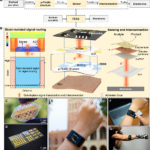A wearable freestanding electrochemical sensing system
Abstract To render high-fidelity wearable biomarker data, understanding and engineering the information delivery pathway from epidermally retrieved biofluid to a readout unit are critical. By examining the biomarker information delivery pathway and recognizing near-zero strained regions within a microfluidic device, a strain-isolated pathway to preserve biomarker data fidelity is engineered. Accordingly, a generalizable and disposable freestanding electrochemical sensing system (FESS) is devised, which simultaneously facilitates sensing and out-of-plane signal interconnection with the aid of double-sided adhesion. The FESS serves as a foundation to realize a system-level design strategy, addressing the challenges of wearable biosensing, in the presence of motion, and integration with consumer electronics. To this end, a FESS-enabled smartwatch was developed, featuring sweat sampling, electrochemical sensing, and data display/transmission, all within a self-contained wearable platform. The FESS-enabled smartwatch was used to monitor the sweat metabolite profiles of individuals in sedentary and high-intensity exercise settings.
Learn about our two Decals!
 Click here to find out more about our Fall Bioinspired Design Decal and our Spring Bioinspired Design in Action Decal – ALL MAJORS are welcome.
Click here to find out more about our Fall Bioinspired Design Decal and our Spring Bioinspired Design in Action Decal – ALL MAJORS are welcome.Berkeley BioDesign Community
 Click here to learn about the BioD: Bio-Inspired Design @ Berkeley student organization or here to signup for more info.
Click here to learn about the BioD: Bio-Inspired Design @ Berkeley student organization or here to signup for more info.Search
Student Login




I imagine that the neurological circuits underlying these processes are governed by both 2d spacing maps with their brains as…
to reduce the impact of car accidents, it may be possible to study the force diverting physics of cockroaches to…
you see this type of head-bobbing stability in many avian creatures related to pigeons like chickens. the head ability to…
not like they taught horses how to run! this is an example of convergent evolution where both sea creatures and…
The brain functions in a similar way with neuronal connections. our brains are able to utilize the multiplicity of connections…